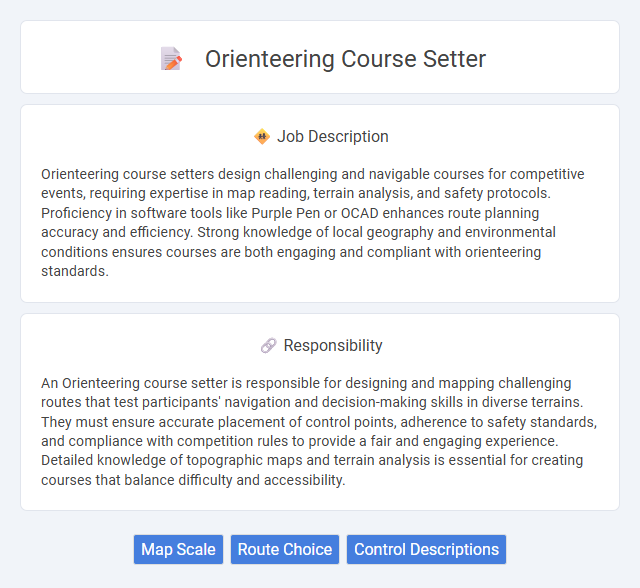
Orienteering course setters design challenging and navigable courses for competitive events, requiring expertise in map reading, terrain analysis, and safety protocols. Proficiency in software tools like Purple Pen or OCAD enhances route planning accuracy and efficiency. Strong knowledge of local geography and environmental conditions ensures courses are both engaging and compliant with orienteering standards.
People who enjoy physical activity and possess strong navigation skills are likely to find the role of an orienteering course setter suitable. Those with a keen eye for detail and a preference for outdoor environments may have a higher probability of excelling in this job. Conversely, individuals who are uncomfortable with physical exertion or lack spatial awareness might struggle with the demands of this position.
Qualification
Orienteering course setters must possess a strong understanding of topography, map reading, and navigation principles to design challenging yet safe courses. Certification from recognized orienteering organizations, such as the International Orienteering Federation (IOF), enhances credibility and ensures adherence to official standards. Experience in outdoor terrain assessment and knowledge of environmental impact considerations are essential qualifications for this role.
Responsibility
An Orienteering course setter is responsible for designing and mapping challenging routes that test participants' navigation and decision-making skills in diverse terrains. They must ensure accurate placement of control points, adherence to safety standards, and compliance with competition rules to provide a fair and engaging experience. Detailed knowledge of topographic maps and terrain analysis is essential for creating courses that balance difficulty and accessibility.
Benefit
Orienteering course setters likely benefit from enhanced problem-solving skills and improved spatial awareness as they design challenging and engaging routes. The job probably offers opportunities for outdoor activity and physical fitness, contributing to overall well-being. Engaging with diverse terrains could also increase adaptability and knowledge of navigation techniques.
Challenge
Orienteering course setters likely face the challenge of designing routes that balance difficulty and accessibility to cater to various skill levels. They probably need to anticipate environmental factors and terrain complexities to create engaging and fair courses. Ensuring safety while maintaining a high level of navigational challenge is expected to be a key aspect of the role.
Career Advancement
Orienteering course setters develop and design challenging navigation courses for competitive events, requiring strong skills in terrain analysis and map interpretation. Mastery in this role opens opportunities for advancement into senior event management, training roles, and positions within national or international orienteering organizations. Expertise in course setting can also lead to career growth in sports event coordination, outdoor education, and adventure tourism sectors.
Key Terms
Map Scale
Orienteering course setters must expertly select map scales that balance detail and readability, typically ranging from 1:7,500 to 1:15,000 for competitive events. Accurate map scale ensures precise control placement and optimal navigation challenges tailored to participant skill levels. Mastery of map scale adjustment directly impacts course fairness, safety, and overall event success.
Route Choice
An orienteering course setter designs routes that challenge participants' decision-making skills by creating strategically varied checkpoints and terrain options. Mastery of route choice involves understanding topography, control placements, and competitors' skill levels to balance difficulty and flow. Effective course setting enhances the navigation experience, encouraging efficient and creative path selection.
Control Descriptions
Control descriptions play a crucial role in an orienteering course setter's responsibilities by providing clear, concise information about each control point's location, features, and identification codes. Accurate control descriptions enhance navigation efficiency, reduce competitor confusion, and ensure that participants can identify controls correctly during the event. Mastery in creating precise and standardized control descriptions directly impacts the overall fairness and success of an orienteering competition.
 kuljobs.com
kuljobs.com